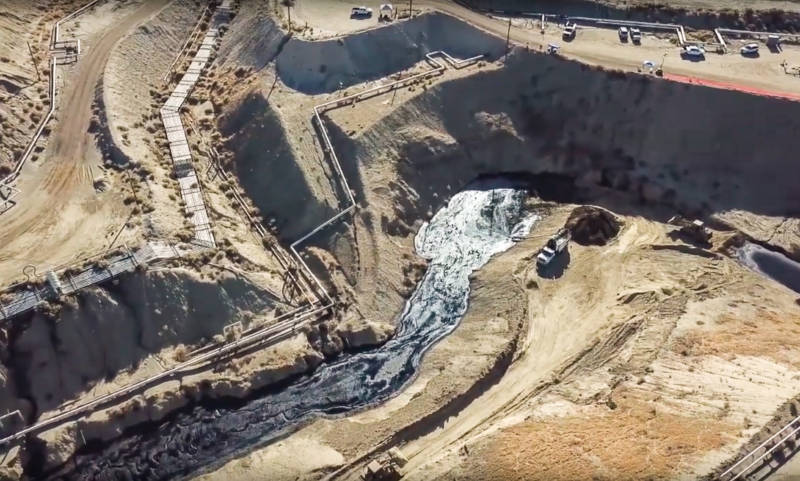"Chevron has provided and continues to provide DOGGR with the broad scope of historical and current technical information DOGGR requested in its September 10, 2019 letter, along with DOGGR’s previous related data requests," Chevron spokeswoman Veronica Flores-Paniagua said.
Tuesday's DOGGR letter comes after the agency cited Chevron for a series of releases industry officials and state regulators call "surface expressions" near its wells on the southeast portion of the 11,000-acre field, 35 miles west of Bakersfield.
Those incidents include one that began in May and released 1.3 million gallons of liquid, including about 400,000 gallons of crude oil, into a dry creek bed before finally stopping in early August. Another expression began later in August and by Monday, nearly 300,000 gallons of fluid had flowed to the surface, including 82,000 gallons of oil.
DOGGR also issued a notice of violation for nearby group of surface expressions that have continued since 2003 and produced tens of millions of gallons of crude petroleum.
Chevron has responded to the agency's violation notices, each of which ordered the company to provide detailed information on the releases, with a sequence of root-cause analyses attempting to explain what the company believes is causing the incidents.
But state regulators' letter Tuesday said the company's material "does not demonstrate to DOGGR’s satisfaction that Chevron has taken all possible steps to mitigate and prevent the occurrence of surface expressions. "
Chevron and other energy companies operating in the area use cyclic steam injection, a process in which vast volumes of high-pressure steam are forced into oil-bearing rock formations far underground, thus freeing the crude for pumping.
The method is effective at accessing hard-to-reach oil deposits, but the history of occasional uncontrolled surface expressions illustrates one risk of the process.
Normally, crude petroleum from underground deposits is pumped to the surface through well bores and shipped by pipelines or tankers for processing. But that's not what's been happening around the leaking Chevron wells, where crude oil, steam and water have apparently moved laterally underground until they find a vent or create a sinkhole that allows the material to come to the surface.
DOGGR's Tuesday letter cited a series of state regulations that require operators using steam injection to demonstrate "that injected fluid will be confined to the approved injection zone and that the underground injection project will not cause damage to life, health, property or natural resources. Chevron’s cyclic steam injection operations in the Cymric field fail to meet these criteria. ..."
Anneliese Anderle, a petroleum engineer who once worked in DOGGR's Bakersfield office, said that the agency appears to be reassessing whether Chevron has shown that it can safely operate steam-injection wells in the Cymric field.
"The bottom line, I guess, is that they're asking to get the project approval letters and all the supporting documents in place," Anderle said. She added that "it seems apparent" that DOGGR's existing approval for Chevron's oil field operations "is flawed."
"There (are) not enough supporting documents," Anderle said. "There has not been oversight when these wells have been approved."
Chevron has said it has worked diligently to try to stop the releases and has said repeatedly that the oil flowing to the surface does not pose a danger to wildlife, water supplies or the region's agricultural sector.
In a recent interview, Richard Hinkley, a senior executive for Chevron's Kern County operations, said the company's crews have drilled new wells and abandoned others in an attempt to alleviate pressure near the surface expressions.
He also said the company has installed advanced detection equipment to measure ground subsidence, a key indicator in monitoring steam-injection wells and the behavior of underground oil reservoirs.
"Chevron is taking this very seriously," Hinkley said. "Our operational goal is to prevent seeps from occurring."
In her Tuesday statement, Chevron's Flores-Paniagua said the company "will continue to diligently work with DOGGR to provide additional information and data based on the schedule that we have previously agreed to with DOGGR, or as otherwise required. We have a dedicated team working to develop a holistic approach to prevent and manage seeps across our Cymric thermal diatomite operations."
In July, the company appealed an order by DOGGR to "take all measures" to stop the flow and prevent a recurrence of the 1Y release.
DOGGR's letter comes two weeks after it announced that it was launching an investigation into operations at the Cymric oil field amid an overall crackdown on "surface expressions" due to a regulation that took effect in April that bans the releases.
The spills are expected to be the subject of a joint oversight hearing by the State Senate and Assembly committees on natural resources in the coming weeks.
